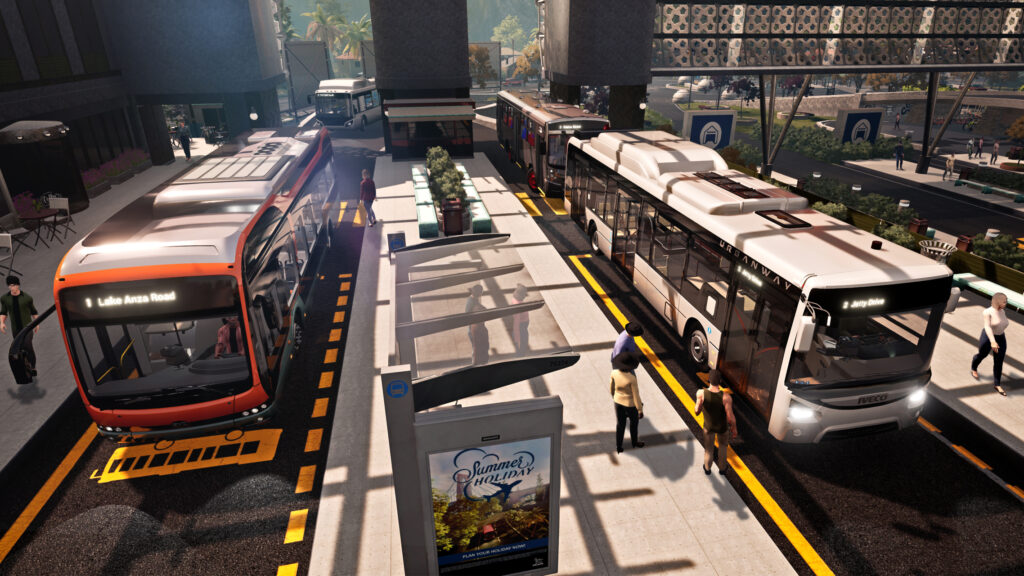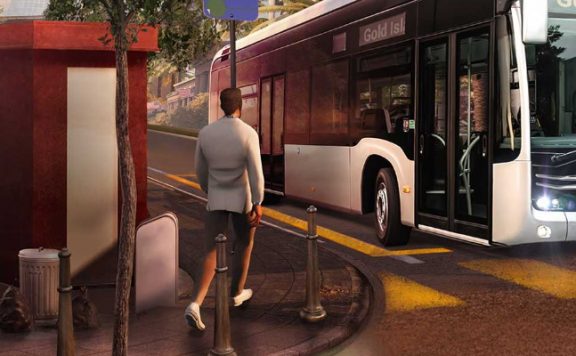Bus Simulator 21 is the third instalment in the franchise from Stillalive Studios, so as you’d expect, they know a thing or two about buses. Three years after Bus Simulator 18, they’re back with their biggest and most detailed game yet.
As you’d expect, Bus Simulator 21 follows the format of previous games as you build your public transport company from the ground up. After completing the tutorial, which guides you through the basic gameplay elements of driving buses and serving stops, you are guided in your quest to public transport domination through a series of step-by-step quests.
You start off in the brand-new open world map of Angel Shores, a fictional US city with a variety of districts. Each area feels unique, from the residential suburbs to the out-of-town shopping mall; there’s plenty to take in. The inner city is also teaming with life, from the busy Downtown to the classic look and feel of Chinatown. Alongside this new map, its European counterpart from previous games, Seaside Valley, also makes a return. While the European style perhaps feels more familiar to me, I think Angel Shores is the more interesting and detailed environment and where I wanted to spend most of my time.

While buying buses and creating routes for your company is a key part of the game, the main emphasis remains on driving the routes yourself. Obeying traffic lights, avoiding other vehicles and pedestrians is obviously what you’d expect to do as a minimum, but you also get extra points for good driving such as using indicators correctly or ‘kneeling’ the bus to allow passengers to board and alight more easily. On the flip side, you’ll lose points for speeding, hitting potholes, clipping the kerb or stopping in a bad position at bus stops. Keeping to timetable is equally important, although I rarely found it to be something I was worried about as the scheduling is quite generous, and you can adjust the travel times and dwell times at bus stops if you need to too.
With 30 officially licensed buses, there’s plenty to choose from. Naturally you’ll start off in small, single deck buses before moving onto larger bendy-buses and, for the first time in the series, late game you’ll unlock the Alexander Dennis double-decker bus (think of your typical red London bus). Keeping with the times, there are also a number of electric buses too.
While the buses are nicely modelled with clickable switches, there are a few bits that let them down. The lighting for example, seems to either be overly bright or barely visible, while simple quality-of-life improvements like dynamic dashboards would be a nice addition so you could easily see the open/close status of the doors.

Driving the buses themselves is a bit hit-and-miss. While the buses feel like heavy, lumbering vehicles that, you’ll especially notice when you switch to a larger bus that has a worse turning circle, the controls can be fiddly. Using a controller takes a bit of getting used to as certain controls are tucked away in the radial menu, and I had a bunch of issues in attempting to set up my steering wheel. But, once you get used to it, you’ll be flying from stop to stop.
Completing routes yourself increases the performance of your employees on the same route when you’re driving elsewhere, so it’s a system that works quite well in encouraging you to drive a variety of different routes and explore the map. Serving bus stops by driving routes yourself also provides them with experience, and with this experience you can level up the bus stop to allow more routes to serve the stop. Once you’ve levelled up all stops in a district, the district level will increase too.
Once you’ve racked up enough mileage, you’ll hit a ‘payday’. With this screen, you can review your finances, browse which routes have been most profitable and spot where you may need to adjust things to maximise their potential. Managing routes is both a blessing and a curse. While it’s nice to be able to do it on the fly without leaving your current bus or route, the UI isn’t the most intuitive. When creating a route, you need to ensure you have a good ‘balance’ of stops. This means that you’ll want to design a route that doesn’t have too many high or low demand stops, as well as thinking about when the stop’s peak time is when looking at the timetables. Some stops have their peak during the morning and evening rush-hours as you would expect, while other stops, such as the ones located Downtown, may actually be busiest in the late evening. This means you’ll want to manage the vehicles in your garage by using them to meet peak demands on specific routes, either through using larger buses or adding more vehicles to the route.

One of the best things about the game is the lack of loading screens. After pre-loading the map on start up, it’s super easy to hop from bus to bus and route to route regardless of where they are without a significant break in play. Once you’ve selected your bus, following the route isn’t your only task. Some passengers will need to purchase tickets, and of course you’ll need to give them the correct change – don’t worry, this isn’t a maths test and the game tells you how much you need! You’ll also need to check for passengers who have conveniently “forgotten” their tickets, or politely ask them to turn down their music and stand clear of the doors. Some passengers use wheelchairs, so you’ll also need to lower the accessibility ramp for them at stops too.
Alongside the ‘campaign’ mode, you can play in sandbox mode which opens up all of the maps straight away and allows you to drive any bus you wish. There’s also a multiplayer mode, which lets you and up to three friends drive around the map together.


